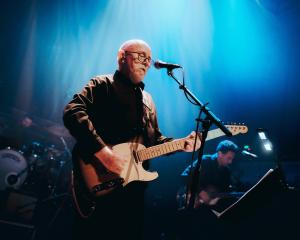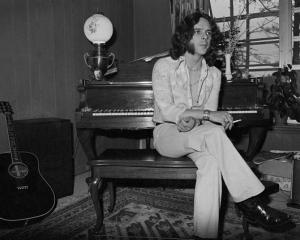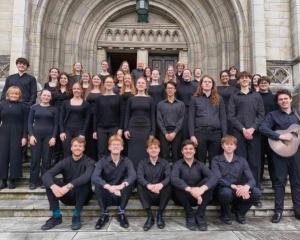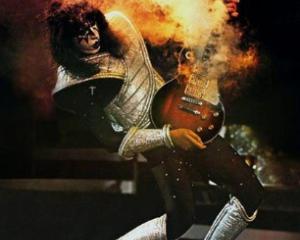From more than 20 countries, 150 musicians including former Dunedin-trained composer Tecwyn Evans, the descendants of opposing forces in World War 1, have been brought together on former European battlefields in a concert-length filmed ‘‘mega symphony''. Rebecca Fox asks New Zealand composer John Psathas how No Man's Land - a unique 75-minute film, projected alongside a group of live musicians on-stage - came about.
The idea grew out of a collaboration with Strike Percussion - a show called Between Zero and One (featured at the 2014 Dunedin Festival) - in which, during one section, a projected mosaic of musicians from around the world played on screen while Strike played live, simultaneously, on stage.
What really surprised me was the feedback I kept receiving about this part of the show. People were really moved by the idea of musicians from around the world playing together like this in front of a live audience. It really made me think about how it might be explored further and meaningfully. And of course that was about the same time that the WW1 commemoration period was getting started.
This idea developed and evolved, in the hands of director Jasmine Millet, into a multilayered film that weaves in and around the live performance on stage. Eventually, there will also be a stand alone theatrical film for cinema.
What message are you trying to get across?
What seems inconceivable, or at least improbable, today - say, peace between Israel and Palestine, or resolution in Syria - was just as improbable for France and Germany (or New Zealand and Turkey) 100 years ago. But here we are, with a modern Europe where the borders have been essentially rubbed off the map.
This idea that - in the furnace of outright conflict - one can imagine a future in which the fighting is over, and the combined descendants of the warring states will congregate on the the exact same soil (as we have done repeatedly in No Man's Land), make music and have fun and play together, is one of the most important ideas I can think of trying to express right now.
What role does music have in trying to generate a conversation about peace?
Music is able to set an example. Within minutes of meeting for the first time, and without sharing a common spoken language, complete strangers can be singing or grooving in total harmony. One example; in Polygon wood, Belgium (a place of terrible events in the first world war), we brought together two young percussionists from Scotland and two from Germany.
These four drummers were standing on the same ground where their ancestors fought each other, and together they totally rocked the tribal and hip-hop grooves in No Man's Land. Music is capable of completely bypassing the borders of geography, age, ethnicity, relative wealth, religion, history, gender and spoken language.
How did you pull together so many musicians?
A lot of emailing! Many of them I knew personally, others I wrote to out of the blue, and I was also introduced and recommended to others by mutual collaborators. During the creation of the music score I skyped a lot. Quite an incredible experience to have legends like Serj Tankian, Meeta Pandit, Bijan Chemirani, Deryan Turkan, and the Refugees of Rap beaming into my studio. For me, No Man's Land is a once-in-a-lifetime privilege; to be working face to face with this global family of profound musical spirits. As well as Mr Evans, who will appear on screen, other New Zealand performers include Ariana Tikao, Joe Callwood, The Nudge (Iraia Whakamoe, Ryan Prebble, James Coyle), Hayden Chisholm, David Downes, Caleb Robertson, James Illingworth and Jack Hooker.
Why combine so many different genres and musicians in one piece?
Music is the ultimate social art form. The only other place you can see so many cultures come together is either in a war, or in a world cup sports championship. Music (and art in general) allows the possibility of cultures to come together in a way that is non-competitive and conflict-free. I was interested in finding the limit; how many cultures could we bring together? I don't think we came close to finding the limit. I don't think there is one.
What was the biggest challenge in creating the piece?
Logistics. We have been blessed with a phenomenally talented behind-the-scenes team setting up an incredibly complex seven-week shoot in Europe, and another week-long shoot in India. Part of that team was our second cameraman Jeff Avery, who is also from Otago.
The other most challenging aspect of the project has been financial. This is a very big project. We have been extremely lucky with support but this aspect of No Man's Land is ongoing. Victoria University, as well as the Lotteries Grants Board, have been our main support pillars, but we have also received support from many others, including the Auckland Arts and New Zealand festivals. A particularly interesting challenge, but also a highlight, was co-ordinating the religious recitations. Religion and spirituality become especially important in times of conflict, so we wanted to represent some of these in the project. We have had amazing experiences filming and recording Muslim, Russian Orthodox, Hebrew, Catholic and Hindi recitations, each of them in profound sacred spaces like the Grand Mosque in Paris, and the Tempel Synagogue in Krakow.
How do you merge so many different genres of music?
We have 155 musicians from 25 different countries. Bringing these musical cultures and styles together was an unforgettable experience. My main role was to work out how to create contexts in which the musicians could be themselves.
How do you rate this work alongside the others you have done?
It's only about a hundred thousand times more difficult than my previously most difficult project, so not too bad. I was very lucky to have three Victoria University master's students on full scholarships working on the project. They came to Europe and India with us, and have been terrific in helping me with the entire music production process. But the entire team and surrounding infrastructure personnel have committed everything they have to making No Man's Land as unique, moving, and powerful as it can be.
See it
NO MAN'S LAND
New Zealand Festival, March 2, Michael Fowler Centre, Wellington.
Auckland Arts Festival, March 4, Great Hall, Auckland.
WOMAD, March 18-20, TSB Bowl of Brooklands, New Plymouth.












